If you’ve ever shopped for granite, you’ve probably heard terms like gangsaw slab, cutter slab, or custom size. But what do they really mean? And how do you decide which one is right for your kitchen, flooring, or wall project? It’s quite common for us to receive calls or emails from clients asking for granite slabs. But when we ask a simple follow-up—“What size are you looking for?”—the answers are often vague: “standard size,” “whatever you have,” or even a counter-question like, “What sizes are available at Stone Galleria?” or “how large are granite slabs?” Even when clients visit our factory, we often need to explain what each size means and suggest the right option based on their project.
This might sound straightforward, but “slab size” doesn’t mean the same thing everywhere. A client in India may think of one size as standard, while buyers in Europe or the USA might expect something completely different.
Understanding granite slab sizes—whether standard or custom—is important because it directly impacts two things: design flexibility and project cost. Choosing the right size ensures the granite fits the space efficiently while minimising wastage, which saves both time and money.
In this guide, we’ll break down the various granite slab sizes available and help you figure out the best fit for your project. We’ll cover everything from standard dimensions to custom options and discuss key factors to consider when choosing the right slab size, including thickness. By the end, you’ll not only know the typical slab dimensions but also be able to answer one of the most common questions we hear: “How many square feet are in a slab of granite?”
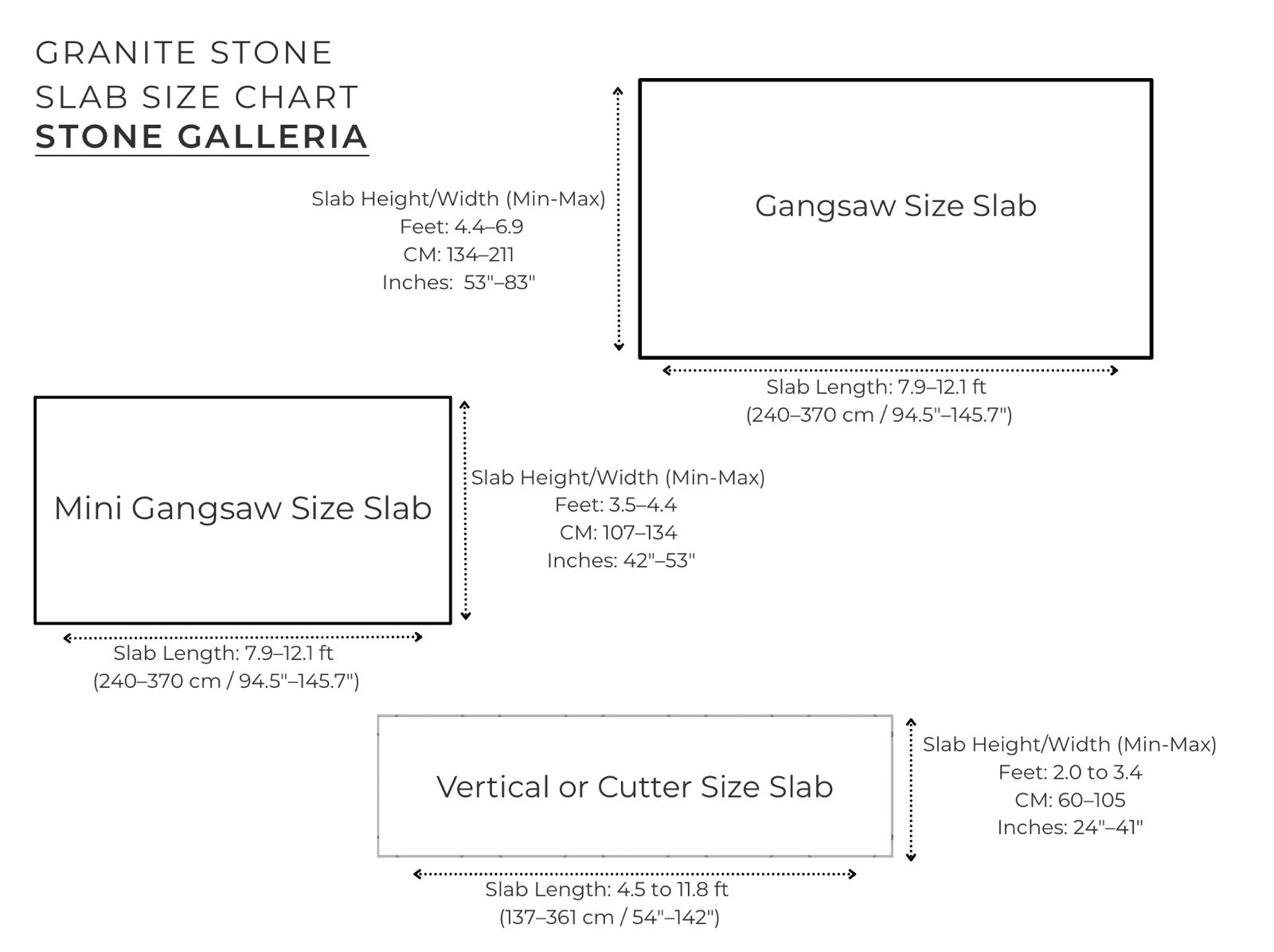
How Large or Small are Granite Slabs?
Granite slabs come in different sizes from large, medium and long and then there are tiles, which are generally much smaller than any types of slabs. Granite slabs are usually classified into three main types based on the sawing/cutting method and size range. The names “gangsaw slab” and “cutter slab” are directly linked to the cutting machinery and methodology used at granite processing plants. Let’s take a closer look at each type and their typical dimensions.
Gangsaw Size Slabs (Large Slabs)
- Length: 240–370 cm (7.9–12.1 ft / 95″–146″)
- Height/Width: 134–211 cm (4.4–6.9 ft / 53″–83″)
- Standard Thickness: 2 CM & 3 CM
Gangsaw slabs are produced using large multi-blade gangsaw machines or modern multi-wire saws, which can cut large granite blocks into the largest slab sizes available, commonly used for big projects like island kitchen countertops, flooring in luxury spaces, and wall cladding or where seams are not desirable.
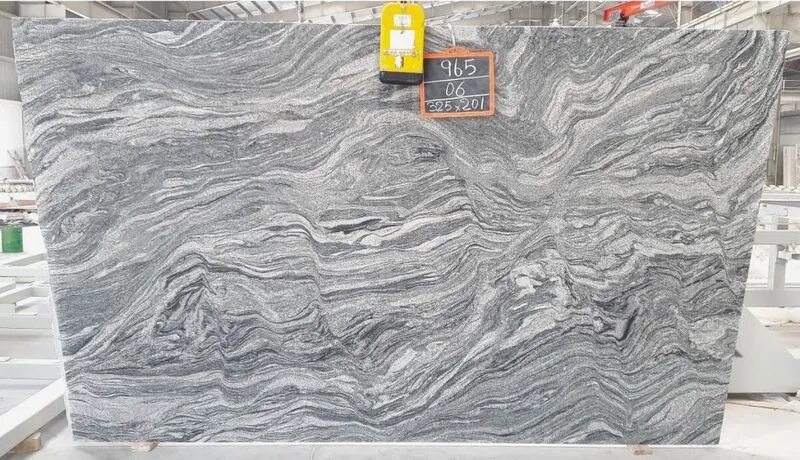
Mini GangSaw Size Slabs (Medium Slabs)
- Length: 240–370 cm (7.9–12.1 ft / 95″–146″)
- Height/Width: 107–134 cm (3.5–4.4 ft / 42″–53″)
- Standard thickness: 18 MM and 2 CM
Not very common due to cost and obsolete technology. Slightly smaller than full gangsaw slabs, they’re preferred where handling or cost efficiency is important. Primary difference is height. it's smaller in terms of height than gangsaw size but taller than next available size i.e., vertical slab size.
Cutter or Vertical Size Slabs (Long Slabs)
- Length: 137–361 cm (4.5–11.8 ft / 54″–142″)
- Height/Width: 60–105 cm (2.0–3.4 ft / 24″–41″)
- Standard Thickness: 16 mm, 18 mm, 2 cm, 25 mm and 3 cm
These are longer slabs, ideal for I, L and galley shape kitchens countertop, bathroom vanities, tiles, and smaller applications where large slabs aren’t required.
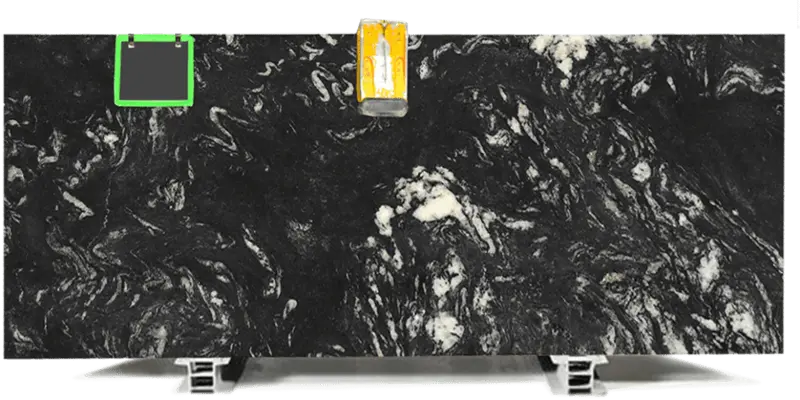
Custom Size Slabs (Cut to Size)
Custom size granite slabs refer to slabs that are not readily available in standard inventory or are in uncommon sizes that factories don’t usually process. In such cases, the slabs are specially cut and finished to match the specific dimensions of a project or customer requirement.
It’s worth noting that this is different from prefabricated granite, which comes in fixed, ready-to-install dimensions (like countertops or vanities). Prefab works well for standard applications, but whenever a project demands unique measurements, custom slabs become the better choice.
It is to be further noted that even within the ambit of gangsaw slabs and vertical (cutter) slabs, there can be many custom size options. These custom slabs are produced when standard inventory sizes do not meet the project’s exact needs.
In other words, while gangsaw and vertical define the broad categories of slab sizes, both can be further tailored in height, length, thickness, or a combination of these factors to create custom-sized slabs for specific applications.
Now that you know slab sizes, let’s see how much area each slab covers.
ALSO READ | Prefabricated vs Custom Size Granite
How Many Square Feet Are in a Slab of Granite?
The square footage of a granite slab depends on its size (length × width). Since granite comes in different slab types, the answer varies:
- Gangsaw Slabs (Large): 35–84 sq ft (3.2–7.8 sq m)
- Mini Gangsaw Slabs (Medium): 28–53 sq ft (2.5–5 sq m)
- Cutter/Vertical Slabs (Small–Long): 9–41 sq ft (0.8–3.7 sq m)
For example, a gangsaw slab measuring 320 × 190 cm (126″ × 75″) covers about 65 square feet. Cutter slabs, being narrower, cover less area per piece.
That’s why there’s no single answer—slab area depends on the type you choose and regional availability.
Granite Slab Dimensions and Area Chart - MM, CM, Inches, Ft, Square feet and Square Meters
| Slab Type | Length | Height / Width | Standard Thickness | Area Range |
|---|---|---|---|---|
| Gangsaw (Large) | 2400–3700 mm 240–370 cm 7.9–12.1 ft 94–146 in | 1340–2110 mm 134–211 cm 4.4–6.9 ft 53–83 in | 20 mm (2 cm) and 30 mm (3 cm) | 35–84 sq ft (3.22–7.81 sq m) |
| Mini Gangsaw (Medium) | 2400–3700 mm 240–370 cm 7.9–12.1 ft 94–146 in | 1070–1340 mm 107–134 cm 3.5–4.4 ft 42–53 in | 18 mm (1.8 cm) and 20 mm (2 cm) | 28–53 sq ft (2.57–4.96 sq m) |
| Cutter / Vertical (Long) | 1370–3610 mm 137–361 cm 4.5–11.8 ft 54–142 in | 600–1050 mm 60–105 cm 2.0–3.4 ft 24–41 in | 16 mm, 18 mm, 20 mm (2 cm), 25 mm, 30 mm (3 cm) | 9–41 sq ft (0.82–3.79 sq m) |
Gangsaw versus Cutter/Vertical Size Slab
Gangsaw slabs and cutter (vertical) slabs are the two main sizes of granite slabs available in the market. These are the sizes buyers encounter most often, which is why we frequently get asked: “What’s the difference between gangsaw size and cutter size?” and “Why is there such a big difference in price?”
Even though they differ in size, comparing gangsaw and cutter slabs is important. It helps buyers, architects, and contractors choose the right slab for their project based on design, budget, handling, and installation needs.
Gangsaw Size Slabs
Gangsaw slabs are large, uniform granite slabs cut using multi-blade or multi-wire gangsaw machines. These machines slice through massive granite blocks to produce expansive slabs.
Standard Sizes:
- Length: 260–370 cm
- Width: 160–220 cm
- Thickness: 2 and 3 4 cm (custom thicknesses available)
Common Applications: Ideal for large-scale projects requiring seamless surfaces, such as kitchen countertops, flooring, wall cladding, and exterior facades. Their size and uniformity make them suitable for applications where minimal joints and consistent patterns are desired.
Advantages:
- Provides a luxurious, uninterrupted look.
- Suitable for expansive areas.
- Offers a premium finish with fewer seams.
Considerations:
- Heavier and bulkier, requiring more effort for handling and installation.
- Higher cost due to size, handing and processing cost due to imported machinery and technology.
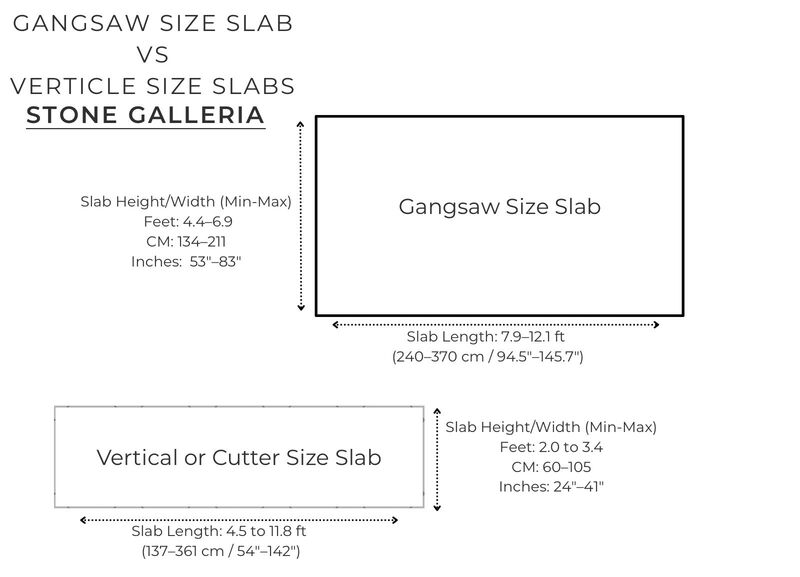
Vertical/Long (Cutter) Size Slabs
Vertical slabs, also known as cutter slabs, are smaller granite slabs cut using vertical multi-blade or wire saw machines. These machines are more compact, allowing for the production of slabs from smaller blocks.
Standard Sizes:
- Length: 260–340 cm
- Width: 60–100 cm
- Thickness: 1.6, 1.8, 2, or 3 cm (custom thicknesses available)
- Common Applications: Perfect for smaller-scale projects like bathroom vanities, stair treads, and decorative wall panels. Their manageable size makes them suitable for areas where large slabs are impractical.
Advantages:
- Easier to handle and install.
- More cost-effective for smaller projects.
- Versatile for various applications.
Considerations:
- May require more joints and seams.
- Not suitable for very large surfaces.
Quick Comparison Table
| Feature | Gangsaw Slabs (Large Slab) | Cutter Slabs (Vertical/Long Slab) |
|---|---|---|
| Size of Slab | Largest slab sizes available | Smaller/mid-size slabs |
| Typical Length | Large (260–370 cm) | Large (260–340 cm) |
| Typical Height | Taller (120 - 210 cm) | Smaller (60 - 100 cm) |
| Typical Thickness | 2 and 3 cm (custom thicknesses available) | 1.6, 1.8, 2 & 3 cm (custom thicknesses available) |
| Price | Generally more expensive due to size and processing cost | More economical and manageable |
| Weight | Heavier | Lighter |
| Applications | Large countertops, flooring, facades | Small countertops, vanities, stairs |
| Handling & Installation | More challenging to transport and install due to size | Easier to handle and install |
| Design Flexibility | High, suited for expansive surfaces with uniform pattern | Good for smaller or more intricate areas |
| Outcome | Offers continuous natural patterns across the slab with fewer interruptions. | More seams are usually needed, so patterns may be interrupted. |
Apart from size and pattern continuity, there is no difference in quality between gangsaw slabs and vertical (cutter) slabs—as long as you source them from a reputable supplier/factory. Both types come from the same types of granite blocks, so their physical and mineral properties—like hardness, density, and durability—are identical.
The main differences you see in price or handling are purely due to:
- Slab size (larger gangsaw slabs require more careful handling)
- Processing and transportation costs
- Ease of handling and installation.
So, whether you choose a gangsaw slab or a vertical slab, you’re getting the same natural stone quality—just in different sizes and formats for your project needs.
ALSO READ | Granite for Building: Exploring the Differences Between Granite Slabs and Tiles
What is the Standard or Most Popular Size of a Granite Slab?
When it comes to granite slab sizes, there are really only three types (each with its own range). However, mini gangsaw slabs are not very relevant anymore for most projects due to practical limitations. This leaves only two main choices:
- Gangsaw size slabs – large, premium slabs
- Vertical (cutter) slabs – smaller, more manageable slabs
The popularity of these sizes depends largely on the region, rather than the type of project (though usage should ideally be the deciding factor).
- In India, Southeast Asia, and some African countries: Vertical slabs are more popular because they are easier to handle, install, design with, and transport, and they are more cost-effective.
- In Europe, Australia, and North America: Gangsaw slabs are more prominent as large seamless surfaces are preferred, and logistics for bigger slabs are more manageable.
Key takeaway: Both gangsaw and vertical slabs are high-quality granite, and the choice should ideally be guided by project requirements, not just trends.
Also READ | Exploring Granite Tiles: Sizes, Applications, and Varieties for Kitchen Countertop and Floor
What is the Standard Thickness of Granite Slabs?
The standard thickness of granite slabs varies according to the slab category—primarily gangsaw slabs and cutter (vertical) slabs. Each category has commonly produced and stocked thicknesses to suit typical market demand.
When referring to standard thickness, it means the thickness that is most readily available in inventory at scale. While customization is possible to match specific projects, these standards reflect commonly stocked sizes.
Gangsaw Slabs
- The typical standard thickness for gangsaw slabs is 2 cm, though in some markets like the USA, 3 cm thickness slabs are more common
- Both 2 cm and 3 cm are considered standard thicknesses worldwide, but availability depends on the granite variety and regional market preferences.
- Most granites are processed at 2 cm thickness globally.
- Certain granite varieties, especially for export markets, may be processed primarily in 3 cm thickness.
Thus, the choice between 2 cm and 3 cm gangsaw slabs depends largely on market demand and the specific type of granite being supplied.
Vertical (Cutter) Slabs
- Cutter slabs generally come in a wider range of thicknesses, commonly 1.6 cm, 1.8 cm, 2 cm, and sometimes 3 cm.
- Like gangsaw slabs, cutter slab thicknesses can be customized based on project needs.
- Certain thicknesses are stocked more often due to typical demands, but special thicknesses can be produced on order.
ALSO READ | What Is the Ideal Granite Thickness for Countertops?
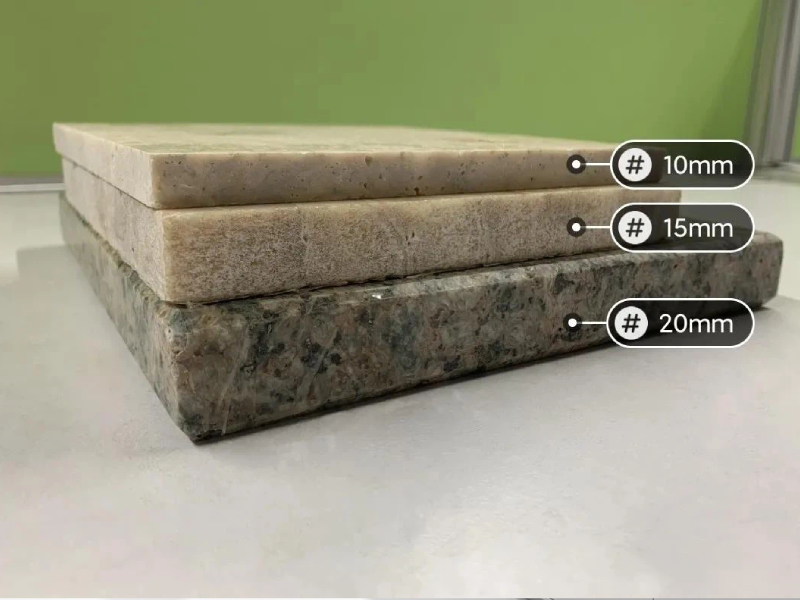
Standard Size Slabs Vs. Custom Size Granite Slabs?
Custom granite slabs are required when a project needs non-standard dimensions that regular gangsaw or vertical slabs can’t provide—like oversized kitchen islands, unique furniture tops, or special architectural features.
While standard slabs are adequate for most projects and are easier to source, custom slabs give designers and builders the flexibility to achieve a perfect fit and unique look where standard sizes fall short.
Standard Granite Slabs
- Slabs cut in widely accepted dimensions (gangsaw or vertical) that factories produce in bulk.
- Availability: Readily available in inventory at scale.
- Common Uses: Everyday projects like kitchen countertops, flooring, wall cladding, staircases, and vanities.
- Advantages: Easy to source, cost-effective, shorter lead time.
- Limitation: Restricted to fixed sizes (length, width, thickness) determined by quarry blocks and factory processing.
Custom Granite Slabs
- Slabs cut and processed in non-standard dimensions to meet a project’s unique requirements.
- Availability: Not generally kept in stock; made to order.
- Customization: Can include height, length, thickness, finish or any combination.
- Common Uses: Luxury interiors, bespoke furniture, large architectural facades, or projects requiring special design fits.
- Advantages: Tailored fit, unique design flexibility, premium appeal.
- Limitation: Longer processing time, higher cost, and may involve extra wastage in cutting.
ALSO READ | Custom Cut Granite: Stair Tiles for Staircase
Why Choosing the Right Granite Slab Size Matters
The outcome of any granite project depends on several factors, including colour, pattern, finish, thickness, slab size, and quality of fabrication. If even one element goes wrong, the entire project can be compromised. Slab size is particularly important — too many seams can spoil the visual appeal, while oversized slabs may lead to unnecessary wastage.
Choosing the right slab size also makes installation and fitting easier, ensuring the pieces align well within the designated space without excessive cutting. This reduces handling risks, minimising fabrication time and labor, and avoids transport challenges that often come with oversized or awkwardly sized slabs.
Conclusion
Selecting the right granite slab size is one of the most important decisions when choosing granite for any project. While most granite varieties come in both gangsaw (large) and cutter (vertical) slab sizes, the choice should be guided primarily by the intended use, design requirements, and budget, rather than just market popularity or availability.
For example:
- Cutter size slabs are typically sufficient for applications such as staircases or I-shaped kitchen countertops where smaller slabs fit well and fewer seams are needed.
- Conversely, areas like island kitchen countertops or luxury feature walls demand a seamless, expansive look, which gangsaw size slabs are best suited to provide.
At Stone Galleria, we process and stock both gangsaw and vertical slabs in multiple thicknesses, so you can order what’s best for your project. And if your design demands something unique, we also cut custom slabs tailored to your exact size. If you’re unsure, our team can guide you to the most cost-effective option while minimizing wastage.


 Fact Checked
Fact Checked





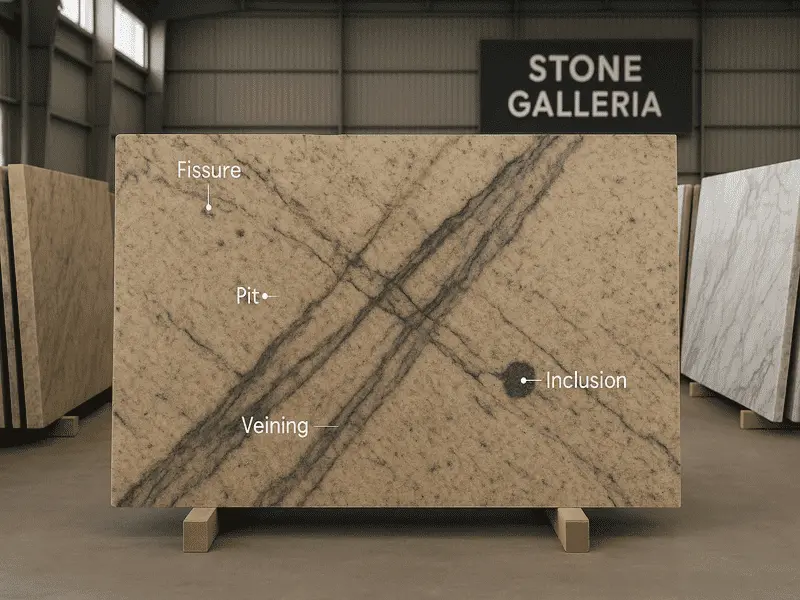
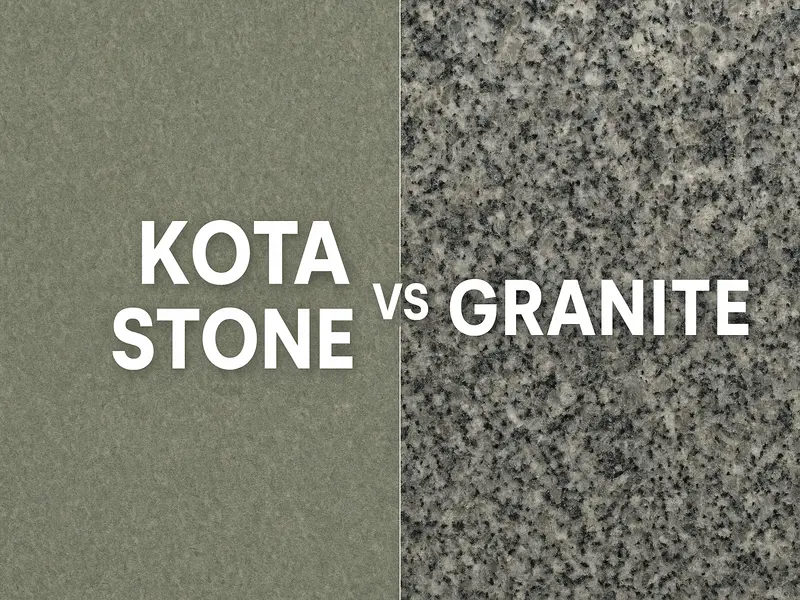



![Latest GST on Granite Slabs & Blocks [2025 Chart + HSN + Price Examples]](https://stonegalleria.in/admin/images/blog/latest-gst-on granite.webp)




